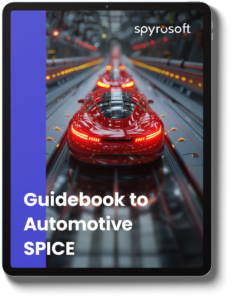ASPICE vs ISO 26262 – what is the difference?
Is compliance with ASPICE a necessity in the automotive industry? Do ASPICE and ISO 26262 requirements overlap? To what extent do they differ?
These questions come up at many business meetings at companies developing automotive systems that already comply with ISO 26262. After all, introducing yet another standard is a time-consuming and costly undertaking.
That’s why we’ve prepared this ASPICE vs ISO 26262 comparison. It explains the differences and similarities between these two standards and provides answers as to whether ASPICE certification is worth the effort.
ISO 26262 vs ASPICE – differences
The key differences between ISO 26262 vs ASPICE lie in their purpose, application, scope and focus:
The purpose
ISO 26262 is the international standard for the functional safety of electrical and electronic systems in road vehicles. The goal of ISO 26262 is to cover all functional safety aspects of the development process. It provides the automotive safety lifecycle: from management, development and production to service. Safety is the main concern of the ISO 26262 standard.
ASPICE, on the contrary, defines best practices and processes for automotive software development that are not necessarily related to safety. It’s used to evaluate whether the supplier meets a specific level of quality and certain safety and performance standards. Based on the audit conducted by external, independent ASPICE-certified assessors, a supplier obtains a capability level from 0 (Incomplete) to 5 (Innovating) for each process in the assessment scope. Levels 2 and 3 are usually perceived by clients as the universal standards for excellence, while levels 4 and 5 are rather treated as aspirations.
The application
The ASPICE assessment concerns process implementation at the organisational, project or system level, while ISO 26262 applies only on a system level. The assessment is performed to ensure that all the functional safety objectives for the determined safety-critical level, are fulfilled correctly.
The scope and focus
ISO 26262 is much more extensive than ASPICE in terms of volume. ISO 26262 contains sections beyond the scope of ASPICE, such as, for example, Item Definition, Risk Management based on ISO 31000, FMEA, FMEDA, FTA, HARA, HW and Production aspects.
The focus of ASPICE is the continuous improvement of the implemented processes to raise the supplier’s capability level. In ISO 26262, the focus is on filling all the gaps in compliance identified by the audit – process improvement is not required unless necessary to achieve compliance. Also, ASPICE takes into consideration the cost and schedule of the development schedule, while ISO 26262 primarily targets functional safety.
Find out more about ASPICE in our guide
Get the ebookIs compliance with ASPICE obligatory for suppliers?
It’s worth noting that compliance with both ISO 26262 and ASPICE isn’t mandatory by any international law, however, it gives a significant competitive advantage in the automotive industry. The leading OEMs, like BMW or Audi, choose their software or electronic suppliers based on their ASPICE assessment rating. Also, so many suppliers adhere to ISO 26262 these days that it is seen as an essential standard in the automotive industry and all major OEMs require that their suppliers comply with it.
To sum up
For critical automotive systems, the best and most recommended approach is adhering to both ASPICE and ISO 26262 standards. This way, the risks of potential failures can be kept at a minimum.
Compliance with ASPICE and ISO 26262 is also a prerequisite for starting business cooperation with the majority of leading OEMs and Tier 1 suppliers who work with the OEMs. It’s a significant competitive advantage that plays a key role in contract negotiations.
If you decide to go through the ASPICE certification process, our experts can provide your team with ASPICE training for any role and at any level. We can also conduct an audit and gap analysis to help you identify areas for improvement and implement the necessary changes.
About the author
RECOMMENDED ARTICLES





